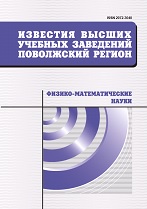|
|
University proceedings. Volga region. Physical and mathematical sciences, 2014, Issue 3, Pages 145–158
(Mi ivpnz339)
|
 |
|
 |
Physics
Ìathematical modeling of teraherz radiation transmission through the graphene monolayers
G. S. Makeevaa, O. A. Golovanovb, V. V. Varenitsac, D. V. Artamonova
a Penza State University, Penza
b Penza branch of the Military Academy of Maintenance Supplies, Penza
c Research and production association "Eshelon", Moscow
Abstract:
Background. Graphene exhibits the unique optical and electronic properties over a broad range of applications and operating frequencies, covering the spectrum from the radiofrequency (RF), the microwave up to the optical region. The aim of the present work is to theoretically research the transmission and interaction of teraherz (THz) radiation with graphene monolayers, using mathematical modeling by solving the Maxwell's equations, complemented by the constitutive law for grapheme. Materials and methods. Using the computational algorithm on autonomous blocks with Floquet channels (FABs) the mathematical model of transmission and interaction of THz radiation with electrodynamic grapheme-based structures was developed by solving the Maxwell boundary value problem, where the graphene electron surface conductivity is included as a parameter and determined from the Kubo formalism. Results. The results of electrodynamic calculation of the real and imaginary parts of complex transmission and reflection coefficients for the TEM mode through the graphene monolayer depending on the frequency were obtained for different values of chemical potential (the external electric field intensity) at the microwave, THz, infrared frequency ranges. Conclusions. This work demonstrates that the transmission and reflection coefficients for the electromagnetic waves through the graphene monolayer can be tuned by the external electric field through the microwave up to the optical region. These results show that graphene monolayers turn out to be extremely interesting solutions for a wide variety of electronic devices and circuits at terahertz frequency range.
Keywords:
graphene monolayer, Kubo formulà, transmission coefficient, reflection coefficient, microwave, teraherz, infrared frequency range, autonomous blocks, Floquet channels.
Citation:
G. S. Makeeva, O. A. Golovanov, V. V. Varenitsa, D. V. Artamonov, “Ìathematical modeling of teraherz radiation transmission through the graphene monolayers”, University proceedings. Volga region. Physical and mathematical sciences, 2014, no. 3, 145–158
Linking options:
https://www.mathnet.ru/eng/ivpnz339 https://www.mathnet.ru/eng/ivpnz/y2014/i3/p145
|

| Statistics & downloads: |
| Abstract page: | 39 | | Full-text PDF : | 21 | | References: | 15 |
|




 Contact us:
Contact us: Terms of Use
Terms of Use
 Registration to the website
Registration to the website Logotypes
Logotypes








 Citation in format
Citation in format 